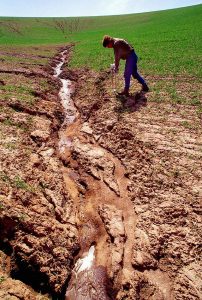Chapter 10: Cultural Practices and Biological Control Methods
10.2 Cultural Practices
Cultural practices for weed control include good agronomic strategies that give your field crop an advantage over the weed competition. As a reminder, the overall goal is to minimize the effects weeds have on the crops. Thinking long term is not always apparent, but is vital. Approaches which reduce the weed seed production will also help with weed management in the future. Therefore, cultural strategies are important to consider in reducing the weed seed bank and giving crops an added advantage over the weeds.
The Foundation – Soil Properties

Provided by USDA-ARS photo library.
Cultural practices include those which help make your crop healthier, and able to better out-compete weeds. Paying attention to a field’s soil conditions, looking at drainage, pH and fertility and addressing any problems with the soil will help the crop grow better.
Interrupting Weed Life Cycles
Crop rotations are a strong research-based cultural strategy to keep weeds off-balance, especially if you rotate to a crop with a different life cycle than the first. By changing from an early season crop to a later season crop, you can make use of different herbicide treatments. This change also puts different pressures on the weed populations so that there is competition at different times of the season throughout a period of several years. Organic farmers make use of this principle quite often.
Hindering Weed Growth
Recall that an earlier chapter in this eBook discussed the resources weeds and crops most often compete for: light, water, and nutrients. Taking that into consideration, there are some cultural approaches which can help the crops better compete for these, thereby limiting weed growth.
- Crop row spacing is an important factor (ie soybeans and corn). Crops planted in narrower rows will close the crop canopy earlier in the growing season and shade out any weeds in between rows
- Planting cover crops has a similar effect by keeping resources away from weeds. In cases of a legume cover crop, it will also add nitrogen to the soil.
- Fertilizer placement may also be able to be adjusted so that it will be near the crop plants versus broadly applied and therefore a large amount of fertilizer being near the weeds and available for their growth.
Reducing Weed Seed Spread
- With a forage crop, mowing before the weeds have a chance to set seed is a good approach to help reduce the weed seed bank and future weed population levels.
- There is a group from Australia who are looking at ways to improve grain crop harvesting to reduce the spread of weeds. Recognizing that when harvesting crops, weed seeds are also being harvested and spread. The researchers are experimenting with different attachments to combines which smash weed seeds before they completely move through the combine and back onto the field. The research indicates good successes in some situations. The following video clip describes this innovative tool being tested by USDA-ARS and University of Illinois https://www.youtube.com/watch?v=MU-atcUQ_ZI